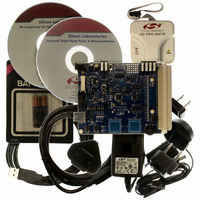C8051F930DK Silicon Laboratories Inc, C8051F930DK Datasheet - Page 91

C8051F930DK
Manufacturer Part Number
C8051F930DK
Description
KIT DEV C8051F920,F921,F930,F931
Manufacturer
Silicon Laboratories Inc
Type
MCUr
Specifications of C8051F930DK
Contents
Target Board, Power Adapter, USB Debug Adapter, Cables, Batteries, and Software
Processor To Be Evaluated
C8051F930
Processor Series
C8051F9xx
Data Bus Width
8 bit
Interface Type
I2C, UART, SPI
Maximum Operating Temperature
+ 85 C
Minimum Operating Temperature
- 40 C
Operating Supply Voltage
0.9 V to 3.6 V
Lead Free Status / RoHS Status
Lead free / RoHS Compliant
For Use With/related Products
C8051F920, F921, F930, F931
Lead Free Status / Rohs Status
Lead free / RoHS Compliant
Other names
336-1473
Available stocks
Company
Part Number
Manufacturer
Quantity
Price
Company:
Part Number:
C8051F930DK
Manufacturer:
Silicon Labs
Quantity:
135
- Current page: 91 of 324
- Download datasheet (3Mb)
7.2.
When a comparator is enabled, its output is a logic 1 if the voltage at the positive input is higher than the
voltage at the negative input. When disabled, the comparator output is a logic 0. The comparator output is
synchronized with the system clock as shown in Figure 7.2. The synchronous “latched” output (CP0, CP1)
can be polled in software (CPnOUT bit), used as an interrupt source, or routed to a Port pin through the
Crossbar.
The asynchronous “raw” comparator output (CP0A, CP1A) is used by the low power mode wakeup logic
and reset decision logic. See the Power Options chapter and the Reset Sources chapter for more details
on how the asynchronous comparator outputs are used to make wake-up and reset decisions. The
asynchronous comparator output can also be routed directly to a Port pin through the Crossbar, and is
available for use outside the device even if the system clock is stopped.
When using a Comparator as an interrupt source, Comparator interrupts can be generated on rising-edge
and/or falling-edge comparator output transitions. Two independent interrupt flags (CPnRIF and CPnFIF)
allow software to determine which edge caused the Comparator interrupt. The comparator rising-edge and
falling-edge interrupt flags are set by hardware when a corresponding edge is detected regardless of the
interrupt enable state. Once set, these bits remain set until cleared by software.
The rising-edge and falling-edge interrupts can be individually enabled using the CPnRIE and CPnFIE
interrupt enable bits in the CPTnMD register. In order for the CPnRIF and/or CPnFIF interrupt flags to gen-
erate an interrupt request to the CPU, the Comparator must be enabled as an interrupt source and global
interrupts must be enabled. See the Interrupt Handler chapter for additional information.
Analog Input Multiplexer
Px.x
Px.x
Px.x
Px.x
Comparator Outputs
Figure 7.2. Comparator 1 Functional Block Diagram
CP1HYP1
CP1HYP0
CP1HYN1
CP1HYN0
CP1OUT
CP1RIF
CP1EN
CP1FIF
CP1 +
CP1 -
+
-
Rev. 1.1
VDD
GND
Decision
C8051F93x-C8051F92x
Reset
CPT0MD
Tree
(ASYNCHRONOUS)
(SYNCHRONIZER)
D
SET
CLR
Q
Q
D
SET
CLR
Q
Q
Rising-edge
CP1
Crossbar
Interrupt
Logic
Falling-edge
Interrupt
CP1
CP1A
CP1
CP1
91
Related parts for C8051F930DK
Image
Part Number
Description
Manufacturer
Datasheet
Request
R
Part Number:
Description:
SMD/C°/SINGLE-ENDED OUTPUT SILICON OSCILLATOR
Manufacturer:
Silicon Laboratories Inc
Part Number:
Description:
Manufacturer:
Silicon Laboratories Inc
Datasheet:
Part Number:
Description:
N/A N/A/SI4010 AES KEYFOB DEMO WITH LCD RX
Manufacturer:
Silicon Laboratories Inc
Datasheet:
Part Number:
Description:
N/A N/A/SI4010 SIMPLIFIED KEY FOB DEMO WITH LED RX
Manufacturer:
Silicon Laboratories Inc
Datasheet:
Part Number:
Description:
N/A/-40 TO 85 OC/EZLINK MODULE; F930/4432 HIGH BAND (REV E/B1)
Manufacturer:
Silicon Laboratories Inc
Part Number:
Description:
EZLink Module; F930/4432 Low Band (rev e/B1)
Manufacturer:
Silicon Laboratories Inc
Part Number:
Description:
I°/4460 10 DBM RADIO TEST CARD 434 MHZ
Manufacturer:
Silicon Laboratories Inc
Part Number:
Description:
I°/4461 14 DBM RADIO TEST CARD 868 MHZ
Manufacturer:
Silicon Laboratories Inc
Part Number:
Description:
I°/4463 20 DBM RFSWITCH RADIO TEST CARD 460 MHZ
Manufacturer:
Silicon Laboratories Inc
Part Number:
Description:
I°/4463 20 DBM RADIO TEST CARD 868 MHZ
Manufacturer:
Silicon Laboratories Inc
Part Number:
Description:
I°/4463 27 DBM RADIO TEST CARD 868 MHZ
Manufacturer:
Silicon Laboratories Inc
Part Number:
Description:
I°/4463 SKYWORKS 30 DBM RADIO TEST CARD 915 MHZ
Manufacturer:
Silicon Laboratories Inc
Part Number:
Description:
N/A N/A/-40 TO 85 OC/4463 RFMD 30 DBM RADIO TEST CARD 915 MHZ
Manufacturer:
Silicon Laboratories Inc
Part Number:
Description:
I°/4463 20 DBM RADIO TEST CARD 169 MHZ
Manufacturer:
Silicon Laboratories Inc











